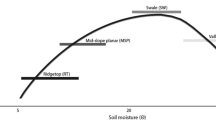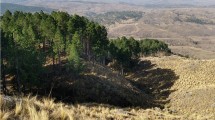Abstract
Background and aims
The roots of tussock-forming plants contribute to the formation of microtopographic features in many ecosystems, but the dynamics of such roots are poorly understood. We examined the spatial heterogeneity of tussock fine root dynamics to investigate allocation patterns and the role of root productivity in the persistence of tussock structures.
Methods
We compared the spatial variability of fine root (<1 mm, 1–2 mm) density, biomass, % live, allocation, turnover rate (using bomb 14C), and productivity of four Carex stricta Lam.-dominated tussock meadows in the upper Midwest, USA (3 reference, 1 restored site).
Results
Relative to underlying microsites, tussocks were warm, dry, and high in root density, productivity, % live biomass, and turnover. Root productivity averaged 649 g m−2 yr−1 (±208) in reference sites, comprised 57 % (±10) of total net production, and was concentrated in tussocks (70 % ± 4). Root turnover rate averaged 0.63 yr−1 (±0.08), but tussocks had ~50 % faster root turnover than the underlying soil, and <1 mm roots turned over ~40 % faster than 1–2 mm roots.
Conclusions
Our detailed analysis of the spatial heterogeneity of tussock root dynamics suggests that high allocation and elevated turnover of tussock roots facilitates organic matter accumulation and tussock persistence over time.





Similar content being viewed by others
References
Aerts R, Berendse F, Klerk NM, Bakker C (1989) Root production and root turnover in two dominant species of wet heathlands. Oecologia 81(3):374–378
Amon JP, Thompson CA, Carpenter QJ, Miner J (2002) Temperate zone fens of the glaciated midwestern USA. Wetlands 22(2):301–317
Bernard JM, Fiala K (1986) Distribution and standing crop of living and dead roots in three wetland Carex species. Bulletin of the Torrey Botanical Society 113(1):1–5
Bloom AJ, Chapin FS III, Mooney HA (1985) Resource limitation in plants- an economic analogy. Annu Rev Ecol Syst 16:363–392
Cahill KN, Kucharik CJ, Foley JA (2009) Prairie restoration and carbon sequestration: difficulties quantifying C sources and sinks using a biometric approach. Ecol Appl 19(8):2185–2201
Camill P, McKone MJ, Sturges ST, Severud WJ, Ellis E, Limmer J, Martin CB, Navratil RT, Purdie AJ, Sandel BS, Talukder S, Trout A (2004) Community and ecosystem level changes in a species-rich tallgrass prairie restoration. Ecol Appl 14(6):1680–1694
Castaneda-Moya E, Twilley R, Rivera-Monroy V, Marx B, Coronado-Molina C, Ewe S (2011) Patterns of root dynamics in mangrove forests along environmental gradients in the Florida coastal everglades, USA. Ecosystems 14:1178–1195
Chapin FS, van Cleve K, Chapin MC (1979) Soil temperature and nutrient cycling in the tussock growth form of Eriophorum vaginatum. J Ecol 67(1):169–189
Chapin FS, Fetcher N, Kielland K, Everett KR, Linkins AE (1988) Productivity and nutrient cycling of Alaskan tundra: enhancement by flowing soil water. Ecology 69(3):693–702
Chapin FS, Matson P, Mooney H (eds) (2002) Principles of terrestrial ecosystem ecology. Springer, New York
Clark DA, Brown S, Kicklighter DW, Chambers JQ, Thomlinson JR, Ni J (2001) Measuring net primary production in forests: concepts and field methods. Ecol Appl 11(2):356–370
Conn CE, Day FP (1997) Root decomposition across a barrier island chronosequence: litter quality and environmental controls. Plant Soil 195(2):351–364
Costello DF (1936) Tussock meadows in southeastern Wisconsin. Bot Gaz 97(3):610–648
Crain CM, Bertness MD (2005) Community impacts of a tussock sedge: is ecosystem engineering important in benign habitats? Ecology 86(10):2695–2704
Day F, Megonigal J (1993) The relationship between variable hydroperiod, production allocation, and belowground organic turnover in forested wetlands. Wetlands 13:115–121
Eissenstat D, Yanai R (1997) The ecology of root lifespan. Adv Ecol Res 27:1–62
Eissenstat D, Wells C, Yanai R, Whitbeck J (2000) Building roots in a changing environment: implications for root longevity. New Phytol 147:33–42
Ervin GN (2005) Spatio- temporally variable effects on a dominant macrophyte on vascular plant neighbors. Wetlands 25(2):317–325
Fahey TJ, Hughes JW (1994) Fine root dynamics in a northern hardwood forest ecosystem, Hubbard Brook Experimental Forest, NH. J Ecol 82(3):533–548
Fitter AH, Graves JD, Self GK, Brown TK, Bogie DS, Taylor K (1998) Root production, turnover and respiration under two grassland types along an altitudinal gradient: influence of temperature and solar radiation. Oecologia 114(1):20–30
Fogel BN, Crain CM, Bertness MD (2004) Community level engineering effects of Triglochin maritima (seaside arrowgrass) in a salt marsh in northern New England, USA. J Ecol 92(4):589–597
Gaudinski J, Trumbore S, Davidson E, Cook A, Markewitz D, Richter D (2001) The age of fine-root carbon in three forests of the eastern United States measured by radiocarbon. Oecologia 129(3):420–429
Gill RA, Jackson RB (2000) Global patterns of root turnover for terrestrial ecosystems. New Phytol 147(1):13–31
Guo D, Li H, Mitchell RJ, Han W, Hendricks JJ, Fahey TJ, Hendrick RL (2008) Fine root heterogeneity by branch order: exploring the discrepancy in root turnover estimates between minirhizotron and carbon isotopic methods. New Phytol 177:443–456
Harmon ME, Phillips DL, Battles JJ, Rassweiler A, Hall RO, Laurenroth WK (2007) Quantifying uncertainty in net primary production measurements. In: Fahey TJ, Knapp AK (eds) Priciples and standards for measuring primary production. Oxford University Press, New York
Herr-Turoff A, Zedler JB (2007) Does morphological plasticity of the Phalaris arundinacea canopy increase invasiveness? Plant Ecol 193:265–277
Hua Q, Barbetti M (2004) Review of tropospheric bomb 14C data for carbon cycle modeling and age calibration purposes. Radiocarbon 46(3):1273–1298
Iversen C, Murphy MT, Allen M, Childs J, Eissenstat D, Lilleskov E, Sarjala T, Sloan V, Sullivan P (2011) Advancing the use of minirhizotrons in wetlands. Plant Soil. doi:10.1007/s11104-011-0953-1
Jackson RB, Mooney HA, Schulze ED (1997) A global budget for fine root biomass, surface area, and nutrient contents. Proc Natl Acad Sci 94(14):7362–7366
Jelinski N (2007) Carbon, land-use and vegetation change: assessing a southern Wisconsin floodplain. M.S. thesis, University of Wisconin-Madison, Madison, WI, USA
Jelinski N, Kucharik CJ, Zedler J (2011) A test of diversity-productivity models in natural, degraded, and restored wet prairies. Restor Ecol 19(2):186–193
Johnson LC, Matchett JR (2001) Fire and grazing regulate belowground processes in tallgrass prairie. Ecology 82(12):3377–3389
Kercher SM, Zedler JB (2004) Flood tolerance in wetland angiosperms: a comparison of invasive and noninvasive species. Aquat Bot 80(2):89–102
Knapp AK, Smith MD (2001) Variation among biomes in temporal dynamics of aboveground primary production. Science 291(481):481–484
Knapp AK, Briggs JM, Childers DL, Sala OE (2007) Estimating aboveground net primary production in grassland- and herbaceous- dominated ecosystems. In: Fahey TJ, Knapp AK (eds) Principles and standards for measuring primary production. Oxford University Press, New York, pp 27–48
Koyama A, Tsuyuzaki S (2010) Effects of sedge and cottongrass tussocks on plant establishment patterns in a post-mined peatland, northern Japan. Wetlands Ecol Manage 18(2):135–148
Kucharik CJ, Fayram NJ, Cahill KN (2006) A paired study of prairie carbon stocks, fluxes, and phenology: comparing the world’s oldest prairie restoration with an adjacent remnant. Global Change Biol 12(1):122–139
Kurtz AMD, Bahr JM, Carpenter QJ, Hunt RJ (2007) The importance of subsurface geology for water source and vegetation communities in Cherokee Marsh, Wisconsin. Wetlands 27(1):189–202
Lawrence BA (2010) Carex stricta tussock formation, persistence, and the capacity to sequester carbon. University of Wisconsin-Madison, Madison
Lawrence BA, Zedler JB (2011) Formation of tussocks by sedges: effects of hydroperiod and nutrients. Ecol Appl 21(5):1745–1759
Levin I, Kromer B (2004) The tropospheric 14CO2 level in mid-latitudes of the Northern Hemisphere (1959–2003). Radiocarbon 46(3):1
Levine JM (2000) Complex interactions in a streamside plant community. Ecology 81:3431–3444
Long SP, Hutchin PR (1991) Primary production in grasslands and coniferous forests with climate change: an overview. Ecol Appl 1:139–156
Lord LA (1996) Competition and dispersal in the regulation of plant species richness on Carex stricta tussocks. PhD thesis, University of New Hampshire, Durham, NH, USA
Lord LA, Lee TD (2001) Interactions of local and regional processes: species richness in tussock sedge communities. Ecology 82(2):313–318
Loya WM, Johnson LC, Nadelhoffer KJ (2004) Seasonal dynamics of leaf- and root-derived C in arctic tundra mesocosms. Soil Biol Biochem 36:655–666
Nishikawa Y (1990) Role of rhizomes in tussock formation by Carex thunbergii var. appendiculata. Ecol Res 5(2):261–269
Peach M, Zedler JB (2006) How tussocks structure sedge meadow vegetation. Wetlands 26(2):322–335
Perelman SB, Burkart SE, León RJC (2003) The role of a native tussock grass (Paspalum quadrifarium Lam.) in structuring plant communities in the Flooding Pampa grasslands, Argentina. Biodivers Conserv 12(2):225–238
R Development Core Team (2011) A language and environment for statistical computing. R Foundation for Statistical Computing Vienna, Austria:http://www.R-project.org
Reuter DD (1986) Sedge meadows of the upper midwest: a stewardship summary. Nat Areas J 6(4):27–34
Rodgers H, Day F, Atkinson R (2003) Fine root dynamics in two atlantic white-cedar wetlands with contrasting hydroperiods. Wetlands 23:941–949
Saarinen T (1996) Biomass and production of two vascular plants in a boreal mesotrophic fen. Can J Bot 76(6):934–938
Shaver G, Billings W (1975) Root production and root turnover in a wet tundra ecosystem, Barrow, Alaska. Ecology 56:401–409
Sullivan PF, Sommerkorn M, Rueth HM, Nadelhoffer KJ, Shaver GR, Welker JM (2007) Climate and species affect fine root production with long-term fertilization in acidic tussock tundra near Toolik Lake, Alaska. Oecologia 153:643–652
Tierney GL, Fahey TJ (2002) Fine root turnover in a northern hardwood forest: a direct comparison of the radiocarbon and minirhizotron methods. Can J For Res 32(9):1692–1697
Tierney GL, Fahey TJ (2007) Estimating belowground primary productivity. In: Fahey TJ, Knapp AK (eds) Principles and standards for measuring primary production. Oxford University Press, New York, pp 120–141
Trumbore SE, Gaudinski JB (2003) The secret lives of roots. Science 302(5649):1344
Tsuyuzaki S, Tsujii T (1992) Size and shape of Carex meyeriana tussocks in an alpine wetland, northern Sichuan Province, China. Can J Bot 70(11):2310–2312
USDA-NRCS (2008) The PLANTS Database (http://plants.usda.gov, 19 February 2008). National Plant Data Center: Baton Rouge, LA 70874-74490 USA
van de Koppel J, Crain CM (2006) Scale-dependent inhibition drives regular tussock spacing in a freshwater marsh. Am Nat 168(5):136–147
van Doorn NS, Battles JJ, Fahey TJ, Siccama TG, Schwarz PA (2011) Links between biomass and tree demography in a northern hardwood forest: a decade of stability and change in Hubbard Brook Valley, New Hampshire. Can J For Res 41:1–11
van Hulzen JB, van Soelen J, Bouma TJ (2007) Morphological variation and habitat modification are strongly correlated for the autogenic ecosystem engineer Spartina anglica (common cordgrass). Estuar Coast 30(1):3–11
Vargas R, Trumbore SE, Allen MF (2009) Evidence of old carbon used to grow new fine roots in a tropical forest. New Phytol 182(3):710–718
Visser E, Bogemann G, Van De Steeg H, Pierik R, Blom P (2000) Flooding tolerance of Carex species in relation to field distribution and aerenchyma formation. New Phytol 148(1):93–103
Vogt K, Persson H (1991) Measuring growth and development of roots. In: Lassoie J, Hinckley TM (eds) Techniques and approaches in forest tree ecophysiology. CRC, Boca Raton, pp 477–501
Walker MD, Walker DA, Auerbach NA (1994) Plant communities of a tussock tundra landscape in the Brooks Range foothills, Alaska. J Veg Sci 5(6):843–866
Wallis E, Raulings E (2011) Relationship between water regine and hummock-building by Melaleuca ericifolia and Phragmites australis in a brackish wetland. Aquat Bot 95:182–188
Werner KJ, Zedler JB (2002) How sedge meadow soils, microtopography, and vegetation respond to sedimentation. Wetlands 22(3):451–466
Yu FH, Krüsi B, Schütz M, Schneller J, Wildi O (2006) Is vegetation inside Carex sempervirens tussocks highly specific or an image of the surrounding vegetation? J Veg Sci 17(5):567–576
Yu FH, Krusi B, Schutz M, Schneller JJ, Wildi O (2008) Plant communities affect the species-area relationship on Carex sempervirens tussocks. Flora 203(3):197–203
Acknowledgements
Research was supported in part by a NSF Doctoral Dissertation Improvement Grant (#0909933) and an ON and EK Allen Fellowship to BAL. We thank James Doherty and Chun Ma for providing field and laboratory assistance, Randy Jackson and Chris Kucharik for technical support, Joe Yavitt and two anonymous reviewers for providing feedback on previous drafts. Kandis Elliot greatly improved Fig. 1. We also thank Cherokee Marsh Conservation Park, Wisconsin DNR State Natural Areas, and Wetlands Research, Inc., for access to research sites.
Author information
Authors and Affiliations
Corresponding author
Additional information
Responsible Editor: Hans Lambers.
Rights and permissions
About this article
Cite this article
Lawrence, B.A., Fahey, T.J. & Zedler, J.B. Root dynamics of Carex stricta-dominated tussock meadows. Plant Soil 364, 325–339 (2013). https://doi.org/10.1007/s11104-012-1360-y
Received:
Accepted:
Published:
Issue Date:
DOI: https://doi.org/10.1007/s11104-012-1360-y




